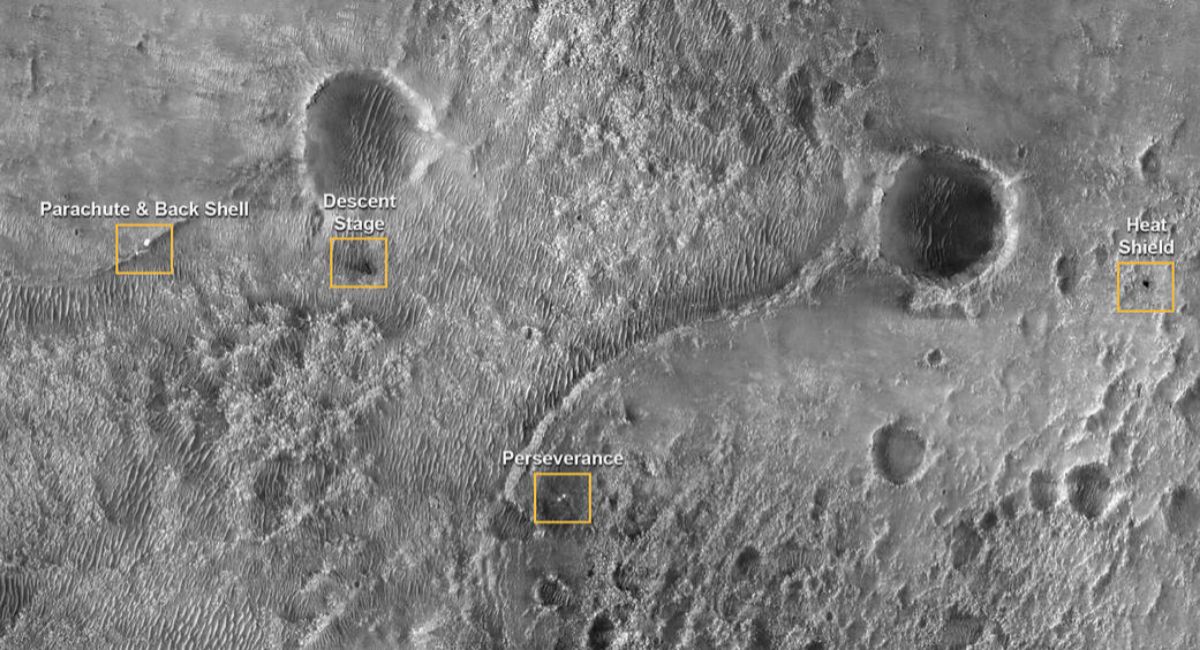In Jezero crater, the Perseverance rover successfully lands on Mars
Exploration.Martemania: this is how the dream of colonizing the red planet advances
Mars2020: seven minutes of heart attack to amartize
Martian analogues: the Turkish 'Martian lake' that showed the way to Perseverance
For many years we have had to get an idea of what it is like to land on Mars through the videos that artistically reconstruct the arrival of robotic vehicles that, until now, could only send photos.
Some, yes, with good quality like those sent by
Curiosity
.
In 2021 we have finally been able to see and hear what Mars really is like thanks to the
Mars2020-Perseverance
rover
.
After the exciting landing last Thursday, NASA has released this week the first audios and videos recorded on the red planet.
And it is that the largest and most expensive robot sent to Mars has incorporated more than twenty cameras distributed among its different instruments.
The complete video, of almost three and a half minutes, combines the images recorded by the robot itself with its navigation cameras (NavCams) and HazCam during the last part of its entry into the Martian atmosphere, the descent and landing in the Jezero crater. with sound from NASA's Jet Propulsion Laboratory (JPL) Control Center in California.
In addition, the US space agency has released two audios recorded by the rover, with and without its own background noise.
For Thomas Zurbuchen, NASA Associate Director of Science,
"This video is the closest you can get to landing on Mars without putting on an astronaut suit."
The video begins when 230 seconds have elapsed since the spacecraft entered the upper atmosphere of Mars at a speed of 20,100 kilometers per hour and shows so much the separation of the capsule that as a shield it protects the
rover
from the high temperatures in that phase initial as the deployment of the 21.5 meter diameter parachute, the largest also that has been sent to Mars.
Panorama taken by 'Perseverance'JPL
NASA had already announced that
Perseverance would
record a battery of data during the seven-minute descent to facilitate the always difficult landings for future larger manned and unmanned spacecraft traveling there in the future.
And although scientists expected these images, Jesús Martínez Frías, head of the Meteorites and Planetary Geosciences (IGEO) group and a member of the Mars2020-Perseverance science team, believes that
"these almost epic images exceed all expectations."
"We placed the EDL camera system on the spacecraft not only to have the opportunity to better understand its performance during entry, descent and landing, but also because we wanted the public to be able to share this journey to the surface of Mars," he said. Explained Dave Gruel, lead engineer for the EDL camera and microphone subsystem at Mars2020-Perseverance.
"We know that the public is fascinated by the exploration of Mars, so we added the EDL Cam microphone to the vehicle because we hoped it could enhance the experience, especially for visually impaired space fans, and engage and inspire people around the world." Gruel added.
Location of the place where the different components of Mars2020-PerseveranceMRO have fallen
"This is more a response of sensations (seeing and hearing) than something scientific, because it takes us to the development 'live and direct' of the mission, almost as if we were watching a movie. But it also reflects, without a doubt, the tremendous NASA capacity. Personally, I am astonished to be a witness of all this and proud to be part of the scientific team of this mission ", says Martínez-Frías, who together with other Spanish researchers from the universities of the Basque Country, Valladolid and Malaga are part of by SuperCamp, one of the seven instruments
Perseverance
carries
.
Two instruments with Spanish contribution
"SuperCam carries a camera, but it is more of a scientific instrument with four spectrometers and two lasers that will remotely analyze rocks and soils on Mars in order to detect organic compounds that could be related to life. It is also able to identify the composition mineralogy and chemistry of geological outcrops at a distance of more than seven meters ", Martínez Frías details through an email.
A part of the 'rover' photographed with one of the cameras.In the upper left part you can see the radiation and dust sensor of the Spanish station MEDA.NASA / JPL-Caltech
Another instrument, the MEDA (Mars Environmental Dynamics Analyzer or Mars Environmental Dynamics Analyzer) meteorological station, has been designed and developed entirely by Spanish researchers.
As reported this Wednesday by the Center for Astrobiology (CAB, CSIC-INTA) and the National Institute of Aerospace Technology (INTA) through a statement, this station equipped with seven sensors
is already working on Mars.
The ignition took place at 02:00 in the morning of last Saturday and everything proceeded normally, although before considering it fully operational, the wind sensor called knife must be deployed (because it is folded over on itself to protect itself from rock impacts during the landing).
According to the criteria of The Trust Project
Know more
Science and Health
science
ScienceUnited Arab Emirates reaches Mars
SpaceThe first black hole detected is much larger than expected
Perseverance rover successfully lands on Mars to search for evidence of past life
See links of interest
Work calendar
Lazio - FC Bayern München
Atlético - Chelsea, live

